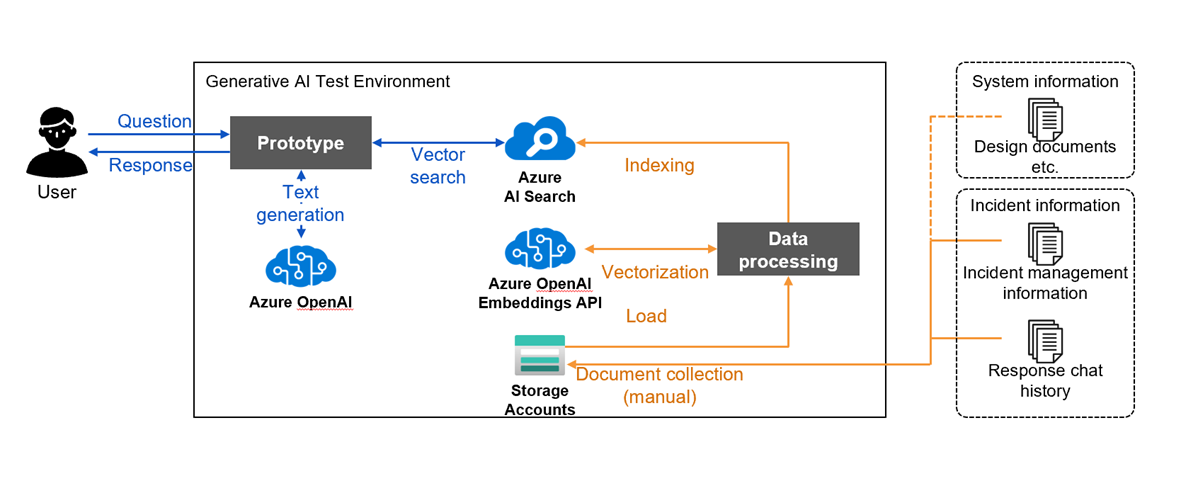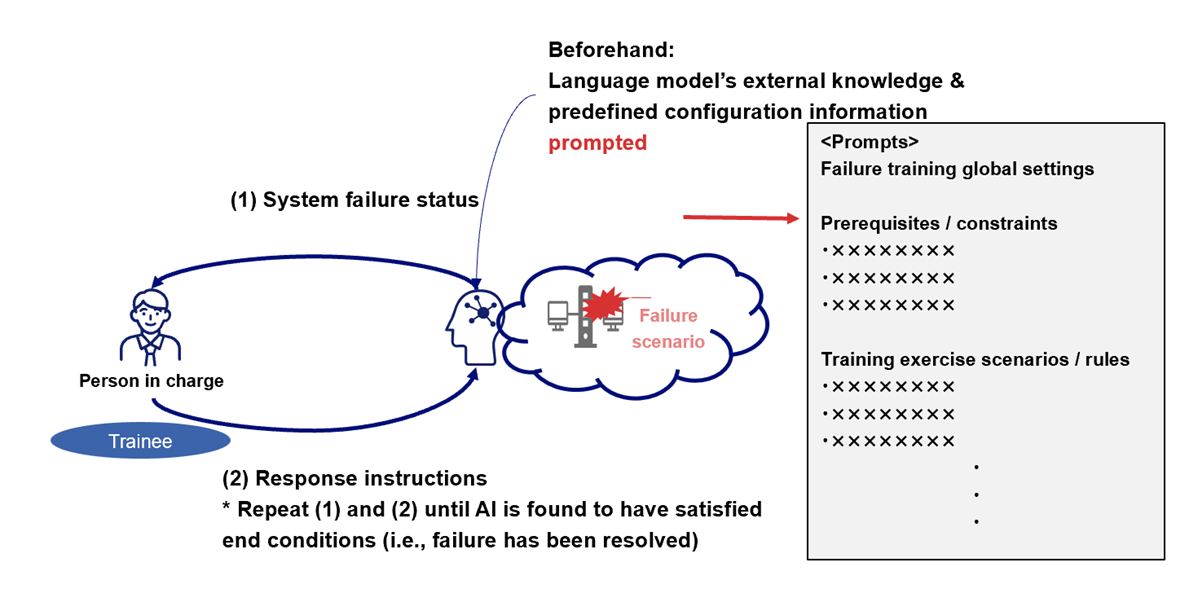As generative AI gains traction in business, many companies are actively leveraging it to develop new services and improve operations. While releases of tools with AI-enhanced features have been announced, use cases beyond enhanced functionalities remain few and adoption in IT operations is still limited. In this blog, we’ll look at real-world use cases and how generative AI could reshape operations engineers' roles and system management's future.
How Generative AI Is Being Used in IT Operations Today
There are currently two main ways generative AI is being utilized in IT operations. One approach is to adopt advanced operational tools with generative AI capabilities already built in. The other approach is to develop custom processes that embed generative AI into in-house workflows tailored to specific organizational needs.
For example, operation tools with generative AI features can:
- Interpret event messages and propose possible causes and incidents
- Visualize relationships between multiple simultaneous events and display their impact on IT services via dashboards
- Suggest solutions based on identified root causes
These capabilities make it easy for IT operations teams to get started with generative AI and significantly enhance day-to-day operations.
While generative AI-powered tools are becoming more widely available, there are still relatively few publicly shared examples of how generative AI is being applied in IT operations outside of these tool integrations.
However, based on various initiatives at NRI and across the industry, we believe the possibilities of generative AI extend well beyond enhancing operational tools. Generative AI has the potential to transform the workflows and skillsets of operations engineers, as well as redefine how IT services are managed.
Real-World Use Cases: How Generative AI Supports IT Operations
Generative AI is no longer just a futuristic concept—it’s already proving useful in IT operations. While many tools rely on general technical knowledge, the real power lies in combining that with your organization’s internal data.
Built-in AI features in operational tools can already analyze system error messages, monitor resource performance and recommend generic countermeasures.
However, these tools often hit a wall when facing system-specific issues. That’s where developing custom AI-driven processes comes in. By integrating internal data—such as system configurations, troubleshooting procedures, and historical incident logs—companies can tailor generative AI to deliver much more precise, actionable responses.
NRI’s Proof of Concept
Here's an overview of a proof-of-concept model tested at NRI. By combining AI’s general technical knowledge with our proprietary internal data, we significantly increased the accuracy of both failure analysis and response recommendations. This model is designed to support operations engineers as they analyze incidents and determine the best course of action.
But that's just the foundation. By incorporating orchestration tools that connect various system functions, we can push this model even further: automating the collection and analysis of incident data, assembling initial recovery procedures, coordinating automated tasks, and even partially automating the early-stage incident response process itself. This powerful combination unlocks greater speed and consistency for IT operations teams, taking incident handling to the next level.

Better Post-Incident Reviews
One of the standout advantages of this AI-driven approach is streamlining the post-incident review process. Not only does it help teams dig deeper into root causes and prevent repeat issues, but it also transforms knowledge-gathering and idea-sharing.
For instance, when it's time to get to the bottom of an incident, the AI takes a few keywords and automatically generates fishbone diagrams or mind maps. Suddenly, teams can see connections and possible causes they might have missed, opening up fresh angles for investigation.
But that’s just the beginning. This model can also take things a step further: by analyzing the challenges identified during a review, AI groups and organizes related issues—making it faster and easier to spot themes, streamline discussions, and drive long-term improvement.
Best of all, the knowledge accumulated from these reviews can be continuously fed back as input to the AI, enhancing the incident response process.
AI-Powered Training
Beyond day-to-day tasks, this model also enables advanced virtual training. Once the system is loaded with configuration data and failure scenarios, engineers can simulate responses in a controlled, risk-free environment.
Think of it as a training simulation—where generative AI plays the role of game master, guiding engineers through failures and testing their response strategies. Early testing has already shown strong results.

Traditional failure training requires live environments, complex planning, and often comes with high costs and risks. Generative AI simplifies it all:
- No need to use production systems
- Lower cost and less prep time
- Easier to run regular training cycles
As AI continues to evolve, it’s clear that IT operations will benefit not only from smarter tools—but also from smarter teams, trained and supported by AI every step of the way.
Potential Benefits and Risks of Generative AI in Operations
Generative AI is already showing strong potential in IT operations. It can support engineers by streamlining failure analysis, automating response planning, and improving post-incident reviews. It also enables safer, more efficient training through simulations, helping teams stay prepared and upskill continuously.
NRI’s internal testing shows that generative AI can effectively leverage past incident data and internal system knowledge to guide both junior and experienced engineers in identifying root causes and potential fixes.
However, there are important risks to consider:
- Data Security: Using proprietary data to train commercial AI models can risk information leaks. Companies should carefully manage input data, review service terms, use private or opt-out-enabled models, and consider deploying AI in secure environments.
- Decision Errors: AI-generated responses may not always be accurate. If applied blindly, they can worsen failures. To mitigate this, automation should be limited to low-risk tasks, while critical decisions remain in human hands.
In short, generative AI can enhance operational efficiency and training—but success depends on thoughtful implementation, human oversight, and strong data governance.
The Future of Generative AI in IT Operations
So far, we’ve looked at how generative AI can improve current operational tasks—like incident response and training. But the future holds even greater potential.
As generative AI continues to evolve, it’s not just about enhancing today's operations. It’s about reshaping how we develop, design, and manage systems altogether.
Rethinking the Operational Model
Traditionally, operational processes have been designed around human roles: define the requirements, design the system, and create supporting tools and procedures. Every reference model—whether tasks, methods, or workflows—has assumed human-led operations. But with generative AI at the core, we can flip that approach.
Instead of designing operations for humans and then adapting AI, we can design operations with AI from the ground up. This means starting with the assumption that operational knowledge and AI capabilities already exist—and asking: What kind of development and operations model makes the most of that?
How Generative AI Could Transform DevOps Processes
Imagine a next-generation DevOps process, powered by generative AI. Here’s how it could work:
- Design Information as Input: Operations engineers could train a generative AI on system architecture, operational methods, and key design details.
- AI-Generated Deliverables: The AI could then automatically produce operational design documents, test cases for operations, or even generate and refine execution scripts.
- Iterative Validation: Automated testing throughout development would validate these assets, enabling a new, AI-centric approach to operational design.
But it doesn’t stop there. It's also possible to feed the AI with valuable operational knowledge—like past incidents, problems, change and release histories—making the system even smarter over time. By integrating this process, DevOps teams could leverage generative AI not only for automation, but also for smarter information access and higher-quality operations in the long run.
New Responsibilities: AI Governance
With AI playing a bigger role in operations, new tasks will also emerge. One of the most critical is AI governance—the ongoing process of monitoring, evaluating, and fine-tuning AI behavior to ensure it meets both security and quality standards.
What’s Next for Generative AI in Operations
Generative AI is already making a practical impact in IT operations—and its potential is just beginning. Beyond improving efficiency, it opens the door to new ways of thinking about system management and team roles.
As adoption grows, operations engineers will need to stay current and actively integrate AI into their workflows.
At NRI, we offer services to help organizations leverage generative AI—whether it’s enhancing operational quality, building response frameworks, or training teams. Ready to take the next step?
Profile
-
Hiroaki IekoPortraits of Hiroaki Ieko
IT Architecture Consulting Department
Joined Nomura Computer Systems (present-day NRI) in 1985. Focuses on ITSM and operations-related consulting.
* Organization names and job titles may differ from the current version.